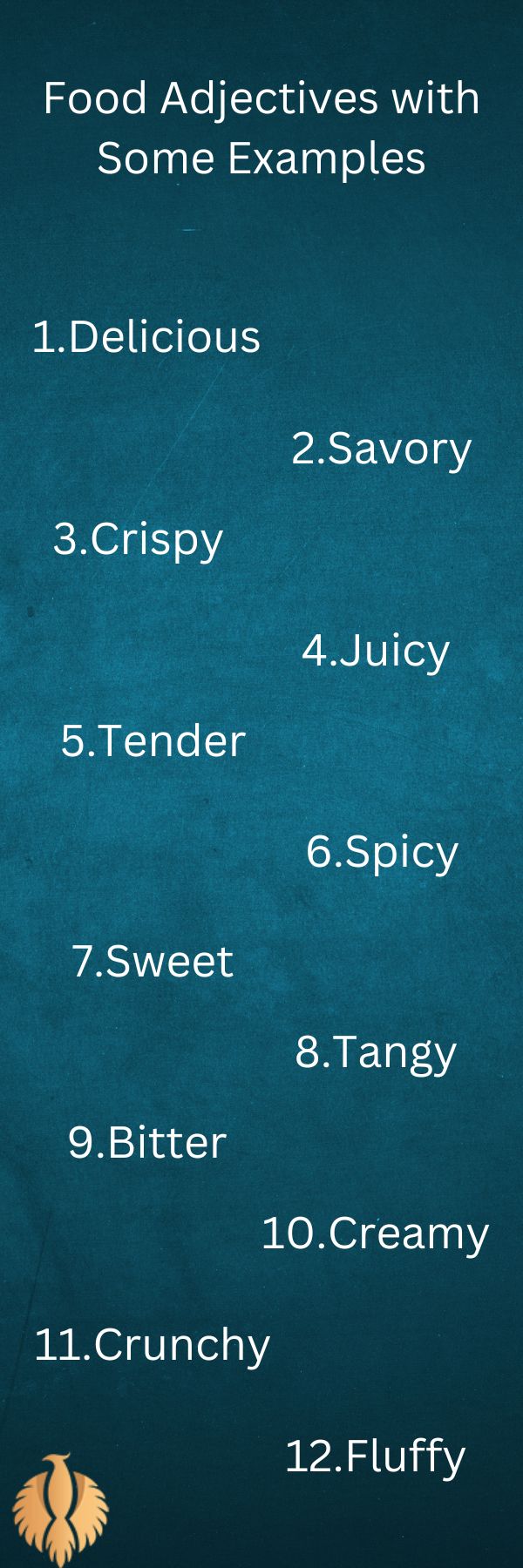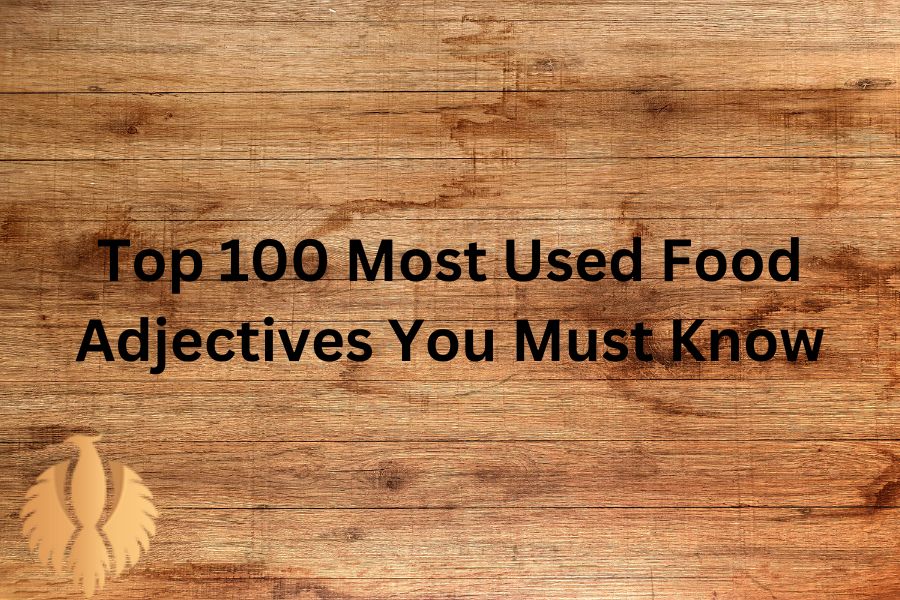When I think about food adjectives, a few immediately come to mind: delicious, savory, and crispy.
These words are not only commonly used but also carry significant weight in describing the culinary experiences we cherish.
Understanding and using the right adjectives can greatly enhance your ability to communicate the essence and appeal of various dishes, whether you are a food enthusiast, a writer, or someone who simply loves to share their culinary adventures.
By mastering these descriptive words, you can make your food descriptions more vivid and engaging, creating a richer and more enjoyable experience for your audience.
Let’s explore these and many more adjectives, providing examples with unique names to make the content original and engaging.
You might also enjoy: Top 100 Commonly Used Verbs That Start With A [2024]
Food Adjectives with Some Examples

1. Delicious: This adjective is often used to describe food that tastes very good.
2. Savory: This word describes food that is salty or spicy rather than sweet. For instance, “The savory aroma of Liam’s beef stew filled the kitchen.”
3. Crispy: This adjective is used for food that is pleasantly crunchy.
4. Juicy: This word describes food that is full of juice. “The juicy watermelon slices were perfect for the hot summer day.” ☀️
5. Tender: This adjective is used for food that is easy to chew or cut.
6. Spicy: This word describes food that has a strong, hot flavor. “The spicy curry that Priya cooked had just the right amount of heat.”
7. Sweet: This adjective is used for food that has a sugary flavor.
8. Tangy: This word describes food that has a sharp, slightly sour taste. “The tangy lemon pie that Sarah baked was refreshing.”
9. Bitter: This adjective is used for food that has a sharp, unpleasant taste. “The bitter coffee was too strong for my liking.”
10. Creamy: This word describes food that has a smooth, rich texture. “The creamy mashed potatoes were a perfect side dish.”
11. Crunchy: This adjective is used for food that makes a loud noise when chewed.
12. Fluffy: This word describes food that is light and airy.
13. Gooey: This adjective is used for food that is sticky and soft. “The gooey chocolate chip cookies were irresistible.”
14. Hearty: This word describes food that is filling and satisfying. “The hearty vegetable soup was perfect for the cold evening.”
15. Rich: This adjective is used for food that has a strong, deep flavor. “The rich chocolate mousse was a decadent dessert.”
16. Zesty: This word describes food that has a strong, pleasant flavor. “The zesty salsa added a kick to the tacos.”
17. Smoky: This adjective is used for food that has a flavor of smoke. “The smoky barbecue ribs were a crowd favorite.”
18. Buttery: This word describes food that has a smooth, rich taste of butter.
19. Peppery: This adjective is used for food that has a strong flavor of pepper.
20. Nutty: This word describes food that has a flavor of nuts. “The nutty flavor of the pesto was enhanced by the toasted pine nuts.”
You might also enjoy: Top 30 Gambling Phrases and Idioms In 2024
21. Velvety: This adjective is used for food that has a smooth, soft texture. “The velvety chocolate ganache was the highlight of the cake.”
22. Piquant: This word describes food that has a pleasantly sharp taste.
23. Succulent: This adjective is used for food that is juicy and tender. “The succulent roast chicken was cooked to perfection.”
24. Luscious: This word describes food that is richly satisfying. “The luscious mango sorbet was a refreshing end to the meal.” ️
25. Delectable: This adjective is used for food that is delicious. “The delectable pastries at the bakery were hard to resist.”
26. Appetizing: This word describes food that looks or smells good. “The appetizing aroma of the freshly baked bread filled the air.”
27. Mouthwatering: This adjective is used for food that looks or smells so good that it makes you want to eat it immediately. “The mouthwatering display of desserts at the patisserie was tempting.”
28. Scrumptious: This word describes food that is extremely tasty. “The scrumptious apple pie that Emma made was a family favorite.”
29. Palatable: This adjective is used for food that is pleasant to taste. “The palatable flavors of the dish were well-balanced.”
30. Flavorful: This word describes food that has a lot of flavor. “The flavorful stew was a hit at the dinner party.”
31. Aromatic: This adjective is used for food that has a pleasant smell. “The aromatic spices in the curry made it irresistible.”
32. Toothsome: This word describes food that is tasty and pleasing to eat. “The toothsome pasta dish was a delight.”
33. Yummy: This adjective is used for food that tastes very good.
34. Tasty: This word describes food that has a good flavor.
35. Satisfying: This adjective is used for food that makes you feel full and content. “The satisfying meal left everyone feeling happy.”
36. Heavenly: This word describes food that tastes or smells very good. “The heavenly aroma of the freshly baked cookies filled the house.”
37. Divine: This adjective is used for food that is extremely good.
38. Exquisite: This word describes food that is extremely beautiful and delicate. “The exquisite presentation of the dish was matched by its flavor.”
39. Ambrosial: This adjective is used for food that is exceptionally pleasing to taste or smell.
40. Gourmet: This word describes food that is of very high quality. “The gourmet meal at the restaurant was worth every penny.”

41. Epicurean: This adjective is used for food that is suitable for an epicure (a person who enjoys high-quality food). “The epicurean delights at the food festival were a treat for the senses.”
42. Delightful: This word describes food that is very pleasant.
43. Enticing: This adjective is used for food that attracts or tempts you. “The enticing aroma of the freshly baked bread drew me into the bakery.”
44. Inviting: This word describes food that looks or smells very good.
45. Irresistible: This adjective is used for food that is so good that you cannot stop yourself from wanting it.
You might also enjoy: Which of the Following: Definition + Complete Usage + Grammar
46. Luscious: This word describes food that is richly satisfying. “The luscious strawberries were a perfect summer treat.”
47. Mouthwatering: This adjective is used for food that looks or smells so good that it makes you want to eat it immediately.
48. Scrumptious: This word describes food that is extremely tasty. “The scrumptious cookies were a hit at the bake sale.”
49. Savory: This adjective is used for food that is salty or spicy rather than sweet. “The savory snacks were perfect for the party.”
50. Succulent: This word describes food that is juicy and tender. “The succulent steak was cooked to perfection.”
51. Tangy: This adjective is used for food that has a sharp, slightly sour taste.
52. Toothsome: This word describes food that is tasty and pleasing to eat. “The toothsome pasta was a delight.”
53. Yummy: This adjective is used for food that tastes very good. “The yummy ice cream was a perfect treat on a hot day.”
54. Tasty: This word describes food that has a good flavor. “The tasty soup was a great start to the meal.”
55. Satisfying: This adjective is used for food that makes you feel full and content. “The satisfying meal left everyone feeling happy.”
56. Heavenly: This word describes food that tastes or smells very good.
57. Divine: This adjective is used for food that is extremely good.
58. Exquisite: This word describes food that is extremely beautiful and delicate. “The exquisite presentation of the dish was matched by its flavor.”
59. Ambrosial: This adjective is used for food that is exceptionally pleasing to taste or smell.
60. Gourmet: This word describes food that is of very high quality. “The gourmet meal at the restaurant was worth every penny.”
61. Epicurean: This adjective is used for food that is suitable for an epicure (a person who enjoys high-quality food). “The epicurean delights at the food festival were a treat for the senses.”
62. Delightful: This word describes food that is very pleasant.
63. Enticing: This adjective is used for food that attracts or tempts you. “The enticing aroma of the freshly baked bread drew me into the bakery.”
64. Inviting: This word describes food that looks or smells very good.
65. Irresistible: This adjective is used for food that is so good that you cannot stop yourself from wanting it.
66. Luscious: This word describes food that is richly satisfying. “The luscious strawberries were a perfect summer treat.”
67. Mouthwatering: This adjective is used for food that looks or smells so good that it makes you want to eat it immediately.
68. Scrumptious: This word describes food that is extremely tasty. “The scrumptious cookies were a hit at the bake sale.”
69. Savory: This adjective is used for food that is salty or spicy rather than sweet. “The savory snacks were perfect for the party.”
70. Succulent: This word describes food that is juicy and tender. “The succulent steak was cooked to perfection.”
You might also enjoy: To Bad Or Too Bad – Correct Grammar + Examples [2024]
71. Tangy: This adjective is used for food that has a sharp, slightly sour taste.
72. Toothsome: This word describes food that is tasty and pleasing to eat. “The toothsome pasta was a delight.”
73. Yummy: This adjective is used for food that tastes very good. “The yummy ice cream was a perfect treat on a hot day.”

74. Tasty: This word describes food that has a good flavor. “The tasty soup was a great start to the meal.”
75. Satisfying: This adjective is used for food that makes you feel full and content. “The satisfying meal left everyone feeling happy.”
76. Heavenly: This word describes food that tastes or smells very good.
77. Divine: This adjective is used for food that is extremely good.
78. Exquisite: This word describes food that is extremely beautiful and delicate. “The exquisite presentation of the dish was matched by its flavor.”
79. Ambrosial: This adjective is used for food that is exceptionally pleasing to taste or smell.
80. Gourmet: This word describes food that is of very high quality. “The gourmet meal at the restaurant was worth every penny.”
You might also enjoy: Boys’ or Boy’s– Which One is Correct? + Example
81. Epicurean: This adjective is used for food that is suitable for an epicure (a person who enjoys high-quality food). “The epicurean delights at the food festival were a treat for the senses.”
82. Delightful: This word describes food that is very pleasant.
83. Enticing: This adjective is used for food that attracts or tempts you. “The enticing aroma of the freshly baked bread drew me into the bakery.”
84. Inviting: This word describes food that looks or smells very good.
85. Irresistible: This adjective is used for food that is so good that you cannot stop yourself from wanting it.
86. Luscious: This word describes food that is richly satisfying. “The luscious strawberries were a perfect summer treat.”
87. Mouthwatering: This adjective is used for food that looks or smells so good that it makes you want to eat it immediately.
88. Scrumptious: This word describes food that is extremely tasty. “The scrumptious cookies were a hit at the bake sale.”
89. Savory: This adjective is used for food that is salty or spicy rather than sweet. “The savory snacks were perfect for the party.”
90. Succulent: This word describes food that is juicy and tender. “The succulent steak was cooked to perfection.”
91. Tangy: This adjective is used for food that has a sharp, slightly sour taste.
92. Toothsome: This word describes food that is tasty and pleasing to eat. “The toothsome pasta was a delight.”
93. Yummy: This adjective is used for food that tastes very good. “The yummy ice cream was a perfect treat on a hot day.”
94. Tasty: This word describes food that has a good flavor. “The tasty soup was a great start to the meal.”
95. Satisfying: This adjective is used for food that makes you feel full and content. “The satisfying meal left everyone feeling happy.”
96. Heavenly: This word describes food that tastes or smells very good.
97. Divine: This adjective is used for food that is extremely good.

98. Exquisite: This word describes food that is extremely beautiful and delicate. “The exquisite presentation of the dish was matched by its flavor.”
99. Ambrosial: This adjective is used for food that is exceptionally pleasing to taste or smell.
100. Fragrant: This adjective describes food that has a pleasant and distinctive smell. “The fragrant herbs in the soup made it incredibly inviting.”
You might also enjoy: Too Cute Meaning Vs To Cute (To Vs Too) + Examples
Conclusion
In conclusion, the world of food adjectives is vast and vibrant, offering a rich palette of words to describe the myriad flavors, textures, and aromas that make our culinary experiences so delightful.
From the delicious chocolate cake that Maria bakes to the savory beef stew prepared by Liam, these adjectives help us convey the essence of our favorite dishes with precision and flair.
Whether it’s the crispy fried chicken that Jake brings to the picnic, or the juicy watermelon slices perfect for a hot summer day, each adjective adds a unique dimension to our descriptions.
Words like tender, spicy, and sweet allow us to paint vivid pictures of our meals, making our language richer and more expressive.
Exploring adjectives such as tangy, bitter, and creamy reveals the diversity of tastes and textures that food can offer.
The crunchy granola in our yogurt, the fluffy pancakes for breakfast, and the gooey chocolate chip cookies we can’t resist all come to life through these descriptive words.
Moreover, adjectives like hearty, rich, and zesty highlight the depth and complexity of flavors that make each dish unique.
The smoky barbecue ribs, the buttery croissants, and the peppery arugula salad each tell their own story through these carefully chosen words.
As we delve into more specialized adjectives such as velvety, piquant, and succulent, we uncover the finer nuances of culinary delights.
The luscious mango sorbet, the delectable pastries, and the appetizing aroma of freshly baked bread all contribute to a richer gastronomic vocabulary.
In essence, these food adjectives not only enhance our descriptions but also deepen our appreciation for the culinary arts.
They allow us to share our experiences more vividly and connect with others over the shared joy of good food. So, the next time you savor a meal, remember the power of these adjectives to capture and convey the magic of each bite.

Hi, welcome to my blog! My name is Omid and I am thrilled to have you here! I am an English language teacher with 12 years of experience and hold multiple international certifications (TESOL, IELTS, TOEFL, PTE, CELTA). Additionally, I hold a PhD in Applied Linguistics with a specialization in Teaching English as a Second Language (TESL), which fuels my passion for teaching English and assisting others in mastering the language. To me, nothing is more rewarding than helping individuals enhance their English language abilities through various methods. So, let’s embark on this journey of learning English together.




